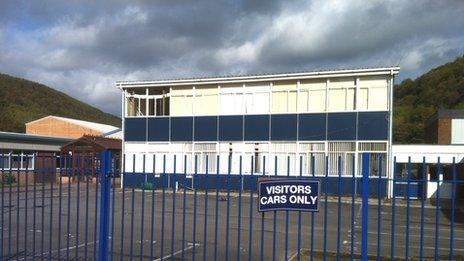Cwmcarn school asbestos should be demolished, says survey
- Published

Asbestos levels at Cwmcarn High School were a 'serious risk,' the report found
Asbestos found at a school poses a potential health risk and the building should be demolished, a report says.
The 900-pupil Cwmcarn High School closed suddenly last month after a structural report identified asbestos in the main block.
The report says asbestos in the roof may have been blown by the heating system and airborne fibres were 10 times higher than the accepted levels.
The union Unison said demolition was the safest option for staff and pupils.
The survey revealed the building "poses potential serious risk to health" and should be demolished, as recommended by a previous inspection.
The Welsh government ordered all schools to report on asbestos levels.
The report, external by Santia Asbestos Management Limited said asbestos in the roof void may have been blown around the building by the heating system.
Ceiling tiles being disturbed by draughts, repairs to the electrical circuit and even pupils scraping chairs and tables in classrooms may have caused damage to asbestos boards, it suggested.
The company said in the report: "We are of the opinion that it is not feasible to continue operating the school in the current condition based on the risks imposed on occupants."
The report said it would not be practical to refurbish the building, removing all the asbestos, given other upgrades and safety improvements that would needed.
Special health clinics have been set up for parents and pupils of the school, which was shut on Friday 12 October.
Students are now being educated 12 miles away at Coleg Gwent's Ebbw Vale campus for the rest of the school year.
Unison Cymru/Wales said it welcomed the recommendation to demolish the school building.
"We believe that this is the safest option for the staff and students alike," Dominic MacAskill, head of local government said.
"Unison will continue to campaign for the safety of the school workforce and our future generations in order to bring this hidden killer under control."
Open windows
Stephen Spiro, professor of respiratory medicine at University College Hospital in London, said it was difficult to know how teachers and pupils might be affected by the asbestos.
"It depends on how long they would have been in the area that's contaminated, how constant the the level of asbestos fibres in the air are," he said.
"It depends enormously on whether windows are open, whether the building or the ceiling tiles are disturbed, whether the heating is on - because the heating will circulate fibres more readily than if the building is cold.
"There will probably be less exposure in the summer than in the winter and it also depends on which type of asbestos fibres these children have been exposed to.
"So all one can say is that it is potentially a situation that you would not want to continue and you really can't estimate the health risk.
"Although it's worrying if the asbestos levels are very high for a long time, by which I mean months or years."
- Published30 October 2012
- Published23 October 2012
- Published19 October 2012
- Published16 October 2012
- Published15 October 2012